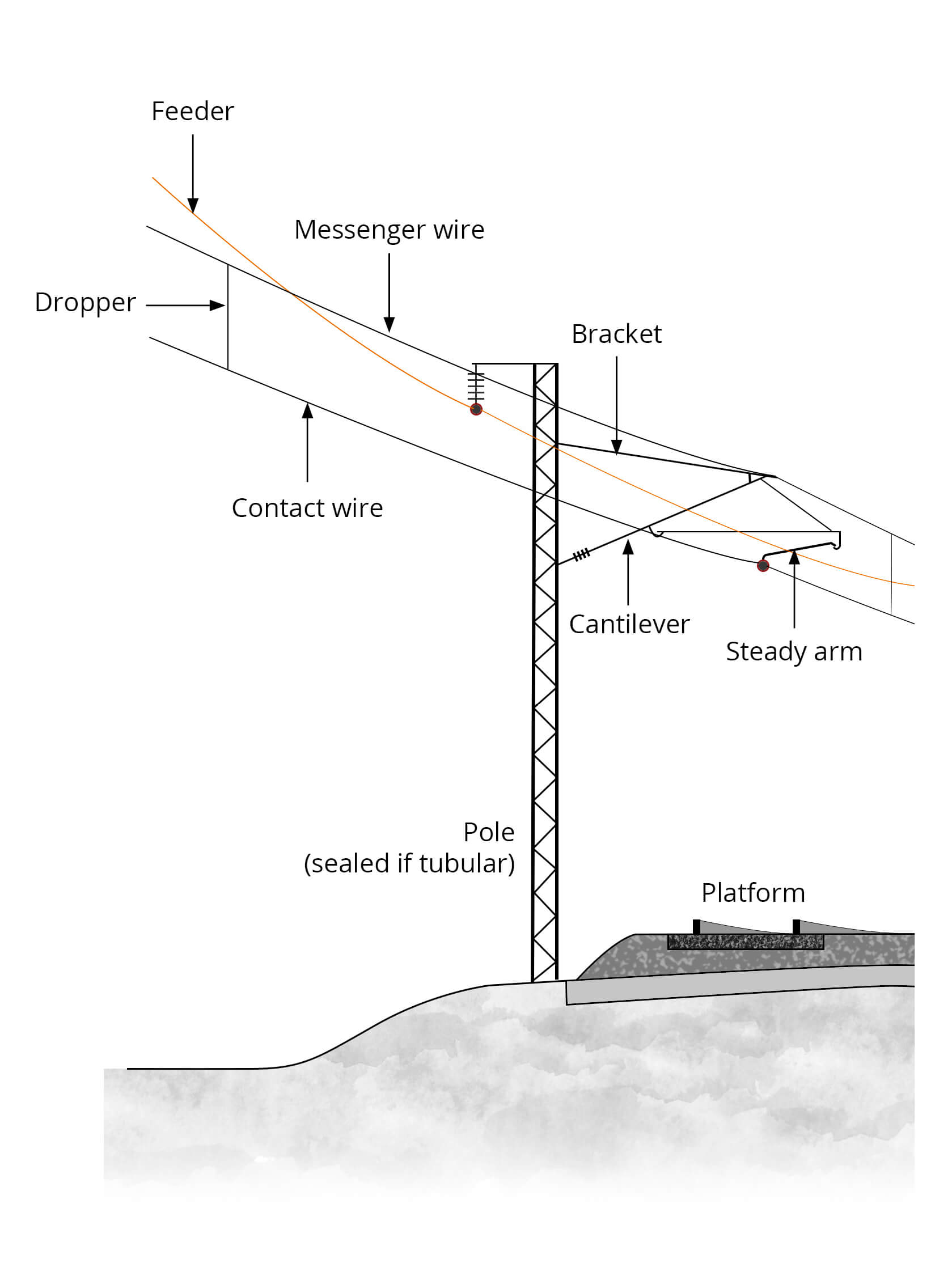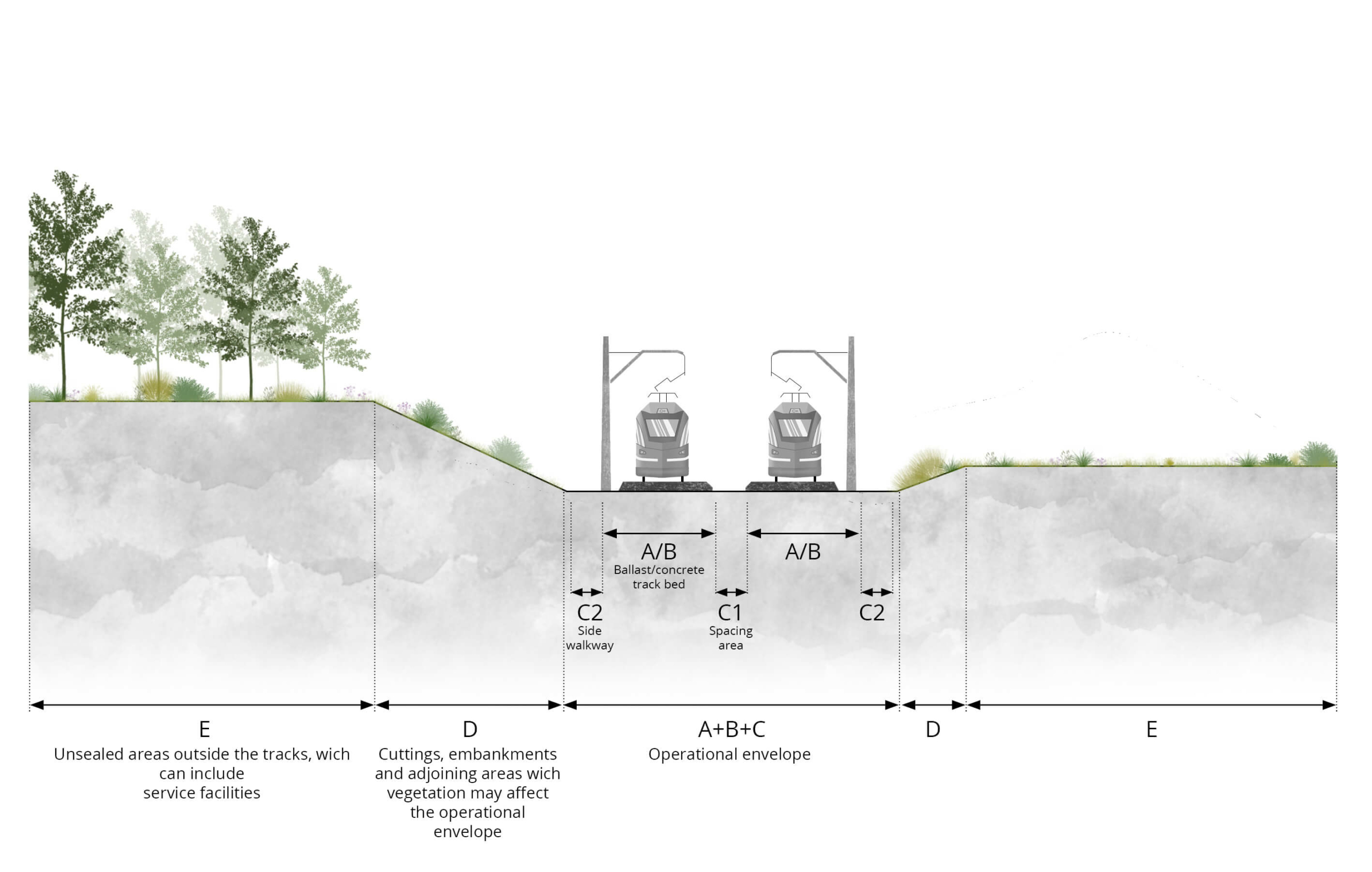RATIONALE. Measures to reduce risks caused by railway electrification systems
Railway systems can have a negative influence on different fauna groups (Borda-de-Água et al., 2017). The most studied and reported impact is wildlife-train collisions (WTC) with mammals. However less is known about how the railway electrification system poses a threat to flying fauna. High-speed railways (HSR) are especially problematic when it comes to bird-collisions due to the heavy wind turbulence created by the passing trains (Malo et al., 2017).
The risk of collision with catenary structures and the attached electric wires can be mitigated by design and management solutions. Some of these approaches entail modifications of the management regime of the nearby vegetation, while others are more specific and aim to change the design of the catenary and electrification system (Malo et al., 2016; 2017).
Innovative system, such as pole screens, have been tested to change bird flight trajectories over the whole catenary structure, reducing the risk of collisions (Zuberogoitia et al., 2015; LIFE Impacto Cero, 2019). Results show a reduction of 32% on bird-collisions for medium and small bird species, with better results for species over 60 cm of wingspan and those that fly in flocks (LIFE Impacto Cero, 2019). These pole barriers can be reinforced with marking elements to reinforce their effectiveness. However, their effectiveness is still low when potential attractants, like carcasses for scavengers, are present (Zuberogoitia et al., 2015).
Railway electrification systems can have a negative impact on different fauna groups. In this section, mitigation measures to reduce the risk posed to fauna by catenary and other elements of the electrification infrastructure are described (Figure 5.10.1).
The most frequent cause of fauna mortality in railway infrastructure systems are wildlife-train collisions (WTC). Less is known about other mortality risks such as electrocution and collisions with the structural components of railway infrastructure systems, such as catenaries and electric wires. More research and monitoring are needed in order to precisely quantify the risks associated to the electrification system. Mortality caused by collisions with railway electric wires has been reported for many bird species, such as buzzard (Buteo sp.), barn owl (Tyto alba), eagle owl (Bubo bubo), lesser kestrel (Falco naumanni), sparrowhawk (Accipiter nisus), song thrush (Turdus philomelos), and starlings (Sturnus sp). Risk of electrocution is reported particularly for birds of prey and owls that are attracted to catenary structures and perches along the railway because of their proximity to hunting grounds on railway verges and trails.
In this section, an overview of the main risks of railway electrification systems to fauna is presented, together with a set of recommendations to reduce them. New research and monitoring could help to precisely quantify the risks associated with electrification systems and establish the effectiveness of measures proposed to reduce these.
Reducing risk of bird and bat collisions and electrocution in railways
The risk of collision with elements of the electrification system is higher in High Speed Railway (HSR) than conventional railways. It is hazardous for birds and bats to fly in the areas where there is risk of collision with trains but also above them, to a height of 5 to 8.5 m, where different elements, such as the catenary, the suspenders, the power wires, the feeder, the earth cable, and the tensors are present (Figure 5.10.1). These elements are located in the operational envelope section including ballast and adjacent areas (Figure 5.10.2. Zones A, B and C) and pose a risk for birds even when trains are not running. Moreover, the risk of collision with those elements may be highly increased by the passage of HSR trains due to strong wind turbulence generated by the moving train that destabilizes the normal flight of birds.
Recommendations to reduce the risk of bird and bat collisions with the catenary system (and also with rails) are described below.
Vegetation management
- Trees and other hedgerow vegetation planted in areas adjacent to the operation envelope (Figure 5.10.2. Zone C) can easily work as a barrier forcing birds and bats to fly above the trains and the elements of the electrification system. However, depending on the specific landscape and habitats surrounding the rail infrastructure, this vegetation could be used for foraging and nesting, and therefore attract wildlife towards the railway area.
- The management regime for vegetation on verges and other green areas associated with railways, close to catenary systems, must be adapted to avoid becoming hunting grounds for birds of prey. Maintaining tall vegetation cover in the area could help to achieve this objective.
Design and screening
- Screens and earthen mounds designed to raise the flight of birds and bats above the catenary can also reduce risk of collision with elements of the HSR structure. Recommendations are described in Section 5.2.10 – Fencing and screening for flying fauna; Section 5.6.2 – Noise; Section 5.7.1 – Verges and other green areas (Figures 5.2.32; Figure 5.2.33; Figure 5.6.5; Figure 5.7.4). These measures can be applied on stretches of railway where high risk of collisions has been identified.
- Pole screens have proven to reduce mortality risk for birds by diverting the flight of medium to large-sized birds above the poles (Figure 5.10.3). These screens can be of different types and materials such as metal or polymers. Height is recommended to be 5 to 8 m high depending on the height of the electrification systems, with a minimum of 2 m high to protect just from collisions with trains. The top part of the poles must be designed to avoid birds perching on them (conic shape or similar) since this would increase collision risk. Poles are recommended to be 8 cm width and located at ~ 2 m from each other, but installed alternatively in both sides of the tracks ‘leaving a visual opening of less than 1 m. A more complex installation with coloured flags attached to the top of the poles to increase visibility may be more effective at creating avoidance effect for birds. These types of screens could be more effective in open areas and close to aquatic habitats while its effect is reduced in forest areas due to flying capacities of forest bird. They have been proposed to be used in viaducts since traditional screens of other materials have important use limitations due to wind effects.
- To avoid electrocution risk for large birds that often perch on poles or other components of the catenary, installing insulation caps to protect this fauna from electrocutions is recommended. Adding protection caps on overhead line masts keeps species such as eagles, owls, sea eagles, imperial eagles, or red and black kites, safe.
- Other measures to reduce collisions and electrocutions with electrical wires and poles can be found on section about risks posed by powerlines (see Section 5.10.2 – Measures to reduce risks caused by powerlines).
Other measures to reduce mortality
- Tops of tubular poles supporting elements of the electrification system must be sealed in order to avoid bird mortality. Nests constructed in the cavity at the top of such poles can slip down inside, trapping the birds and cause death or injuries. A sealed cover at the top prevents this.
- Where catenary systems have uncapped poles that cannot be sealed, an alternative is to open or widen drainage holes at the bottom of the poles to allow trapped birds to escape. However, this is not ideal because birds can still get injured from being inside poles, and such escape measures may also become blocked and end up ineffective.
- Routine monitoring. including searching for carcasses, along railway tracks and inspection of uncapped poles helps identify mortality hotspots and the efficient planning of where corrective measures are most needed.


